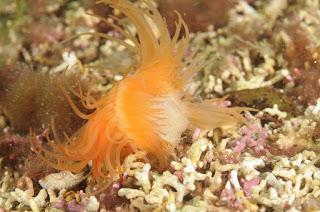
A flame shell on a shallow water maerl bed in outer Loch Carron
© SNH
The world’s largest known colony of a brilliant but shy species of shellfish has been discovered in a west coast Marine Protected Area (MPA).An eye-watering quarter of a billion flame shells have been found living in nests which have merged to form a huge 185 hectare bed at the bottom of Loch Carron. Flame shells are small bivalve molluscs with fiery orange tentacles. Flame shells spend most of their lives completely hidden away inside nests, built from old shells, stones and other materials around them and bound together with thin wiry threads.The discovery was made during a joint Scottish Natural Heritage (SNH), Marine Scotland (MS) and Heriot-Watt University (HWU) survey to learn more about habitats in Loch Carron. The latest find further highlights the global importance of Scotland for the species, following on from a 2012 discovery in Loch Alsh of a colony of more than 100 million flame shells.Mike Cantlay, SNH’s Chair, said: "Scotland’s Seas clearly still have many secrets left to tell. This is a remarkable discovery and I think we should be proud that our rich waters are so important to flame shells, and as our marine research and survey work continues to reveal, many other wonderful species too.”Environment Secretary Roseanna Cunningham said: “This is a fantastic discovery which shows that the new Marine Protected Area is making an even more valuable contribution to safeguarding these waters than we first thought.“I am determined to protect Scotland’s rich marine environment as this example shows the importance of considering how our seas are conserved beyond the MPA network. We are continuing to work with SNH to review the most vulnerable Priority Marine Features in our coastal waters.”Dr Dan Harries, of Heriot-Watt University's Institute of Life & Earth Sciences which who led the diving fieldwork, said: "This is another fantastic discovery. We really didn’t think we’d find a bed that could top the 100,000,000 find in Loch Alsh. This is a great example of partnership working across Government departments, SNH and academia to deliver a timely and scientifically robust response.”

